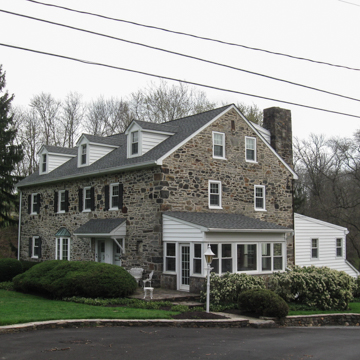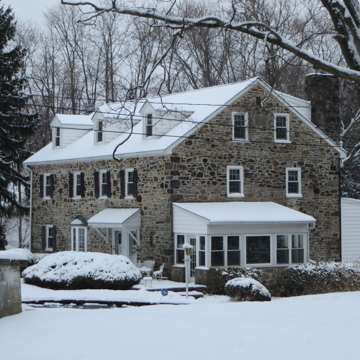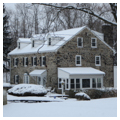Mill villages were keys to the prosperity of northern New Castle County. Farmers raised barley, corn, oats, and wheat, ground at water-powered establishments. Woolen mills allowed them to raise sheep, too. Modern commuters are hardly aware of Milltown today; the old five-points arrangement (radiating starlike in five directions) of colonial roads was cut off by highway rerouting in 1964. Milling got underway at this site on Mill Creek by 1747. Caleb Harlan was involved from 1771 to 1815, when his will conveyed “mill, millstones and every other appurtanances” to his sons and the present structure was built, as shown in a datestone. Abram Chandler purchased it in 1852 and, by 1871, had erected the extant brick house nearby with its elegant cast-iron veranda. The mill's rectangular plan and huge corner chimney (once warming an enclosed office inside), as well as its having the race flow through the building to turn the waterwheel and grinding machinery at one end, are derived from Chester County, Pennsylvania, practice (as disseminated widely by Oliver Evans's book of 1795 on mill technology). Harlan Mill ceased operation in the 1890s and was gutted by fire in the 1940s. Today it is a private home. To the west (on the current site of Dickinson High) stood the Thomas Springer log dwelling (c. 1795), installed at the Smithsonian Institution as “the Delaware Plank House” (1958–1963, Robert L. Raley, with curator John Pearce). Barbara Clark Smith's book After the Revolution (1985) discusses its former neighborhood.
You are here
Harlan Mill
If SAH Archipedia has been useful to you, please consider supporting it.
SAH Archipedia tells the story of the United States through its buildings, landscapes, and cities. This freely available resource empowers the public with authoritative knowledge that deepens their understanding and appreciation of the built environment. But the Society of Architectural Historians, which created SAH Archipedia with University of Virginia Press, needs your support to maintain the high-caliber research, writing, photography, cartography, editing, design, and programming that make SAH Archipedia a trusted online resource available to all who value the history of place, heritage tourism, and learning.


















